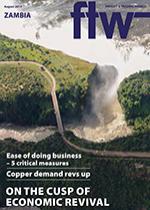Newly appointed Walvis Bay Corridor Group (WBCG) Zambian business development manager James Kaposa brings a strong background in trading to the marketing of the route.
Kaposa has been involved in the marketing and trading of pet food and fish. He sees his challenge as one of changing perceptions.
“Zambia’s trade routes are traditionally tilted towards the eastern ports for historical reasons. “Our message is that the route south via Walvis Bay is open, and that it is the natural gateway for trade with the United States, Europe and South America.”
There are also direct calls from the east.
“It is an efficient and open corridor, with the biggest challenge being the balancing of loads,” says Kaposa.
According to Clive Smith, WBCG logistics hub project manager, Walvis Bay has direct calls from Europe, the Far East, North America and the Middle East.
This is where his trading experience and background could help tilt the flow of trade to the south-west. As an independent organisation which is not involved in logistics itself the WBCG helps freight forwarders, shippers and hauliers to identify and exploit opportunities on the Walvis Bay – Ndola – Lubumbashi corridor.
Smith says cargo landed in Walvis Bay is typically delivered in Zambia within three to four days, and in the Democratic Republic of Congo within five to six days.
Efficiencies are improving all the time, with ongoing investment in road and rail links as well as the expansion of the port, with a new container terminal due to come on stream in 2019.
Zambian importers and exporters also have the advantage of a duty-free dry port facility within the borders of the port of Walvis Bay.
“There is a big emphasis on safety and security, with the Walvis Bay corridor being recognised as the safest of the four serving the Copperbelt,” says Kaposa.

